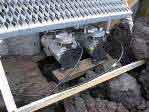More than two years after road access and electrical power to the Mauna Loa Observatory was cut off by lava flows, NOAA staff continue to make critical measurements of the atmosphere and other environmental variables at the remote site.
In 2023, observatory staff installed solar panels at the site and resumed some measurements, including the independent carbon dioxide monitoring programs run by the Global Monitoring Laboratory and Scripps Institution of Oceanography, as well as other atmospheric measurements.
Construction of a temporary road to access the observatory site is anticipated to begin in summer 2025.
Media can contact: Theo Stein (303) 819-7409 (theo.stein@noaa.gov)
Organization(s):
 University of California,
Davis
University of California,
Davis
What does this program measure?
Fine particle (PM-2.5) mass and elemental concentrations, in ug/m3
How does this program work?
A multi-filter sampling system, the UC-DAVIS IMPROVE system is used for long term trend study. Fine particles are captured on filters after passing through a size-selective inlet to remove large particles. Specifically, one set of filters take the samples continuously and the other set takes samples only during times when down slope flow is expected. Particles >2.5 micrometers are excluded from the collected sample by passing the sample air stream through a cyclone separator. Each filter operates over a three day period. Filters are changed weekly. The filters are shipped to a laboratory where they are weighed and are then subjected to elemental analysis. Special studies involve rotating drum impactors (size, time, elemental compost ion) and HI-Vol filters (isotopes, chemistry).
Why is this research important?
To determine the diurnal (daily) behavior and long term trends of high elevation, global background fine particle concentrations.
Are there any trends in the data?
The purpose of this project is to obtain ambient atmospheric fine particle concentration data for size, time, and composition at MLO and to compare this data with similar samples from other remote Hawaiian and mainland locations, especially Asia. We are planning to use the MLO IMPROVE data to evaluate the long term changes in the output of Asian pollutants, since MLO is so closely coupled to Asia each Spring and Summer.
How does this program fit into the big picture?
What is it's role in global climate change?
These measurements provide insight into global background fine particle concentrations at high elevation in the mid-Pacific. Special emphasis is placed on those factors which affect radiative climate forcing and visibility. High time resolved aerosol data are then compared to standard MLO gas and optical data.
Comments and References
- Perry, Kevin D., Thomas A. Cahill, Russell C. Schnell, and Joyce M. Harris. Long-range transport of anthropogenic aerosols to the NOAA Baseline Station at Mauna Loa Observatory, Hawaii. Journal of Geophysical Research Atmospheres. Vol. 104, No. D15, Pages 18,521-18,533 (1999).
- Cahill, Thomas A., and Kevin D. Perry. Asian transport of aerosols to Mauna Loa Observatory, Spring 1994. Climate Monitoring and Diagnostics Laboratory, No. 23, Summary Report 1994-1995, U.S. Department of Commerce National Oceanic and Atmospheric Administration Environmental Research Laboratories/CMDL 94-95, pp 114-116.
Lead Investigator(s):
Dr. Charles E. McDade
530-752-7119
Mike Brown
530-754-9741
MLO Contact(s):
Trevor Kaplan
808-933-6965 (x226)
Paul Fukumura
808-933-6965 (x223)
Web Site(s)
http://vista.cira.colostate.edu/improve
Date Started
1998

